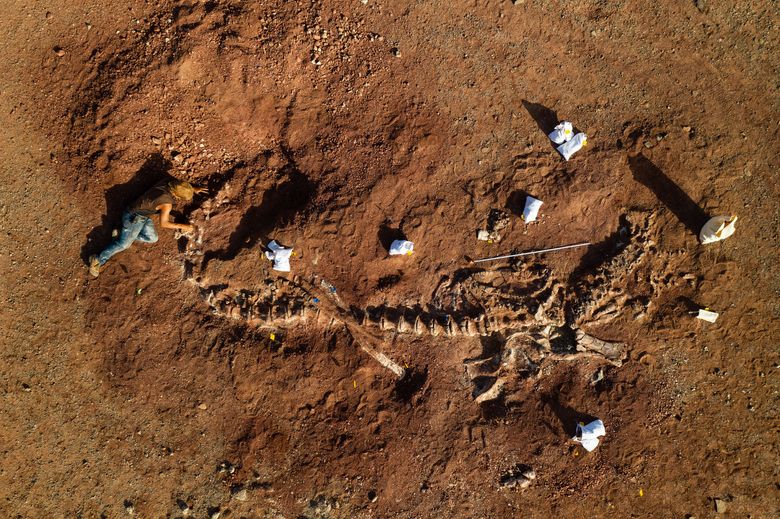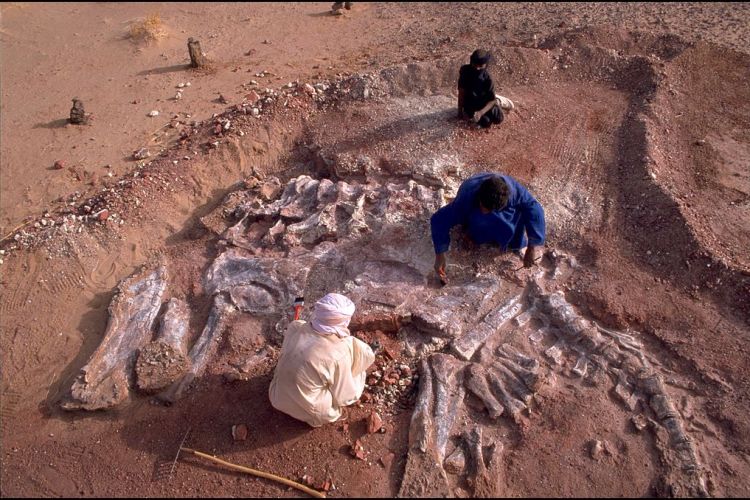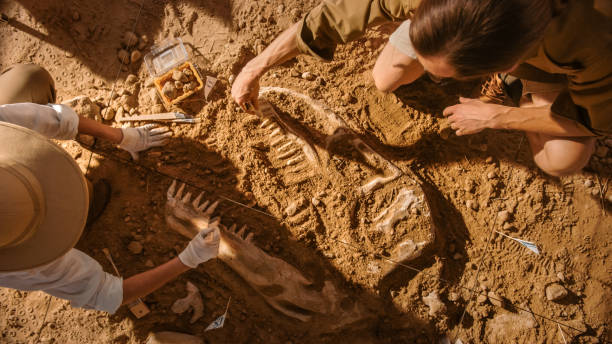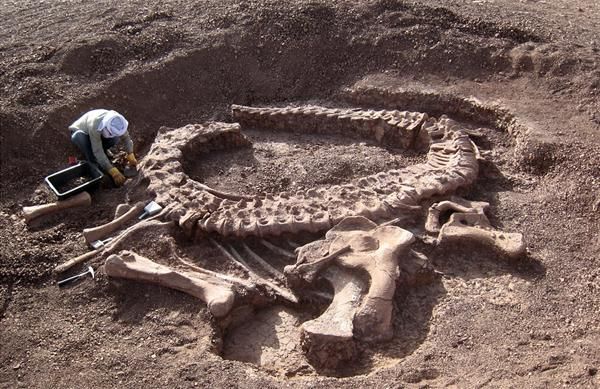In secret patches of the south-central Sahara, blankets of sand hide 20 tonnes of dinosaur bones.
There are flying reptiles. A creature that resembles an armoured dog. Eleven species yet to be identified – all with long necks. They roamed the desert when it was still green, scientists concluded, as far back as 200 million years ago.

This is one of Africa’s biggest fossil caches, a prehistoric graveyard that sparked dreams of a world-class exhibition in Niger. The rare discovery is vulnerable to looters and collapsing dunes. But excavation must wait as the nation confronts a second wave of the coronavirus on top of escalating Islamist insurgencies.
“This is our cultural identity,” said Boubé Adamou, an archaeologist at the Institute for Research in Human Sciences in the capital, Niamey, who helped uncover the haul. “But saving the living comes first.”
Niger, about twice the size of France and two-thirds desert, has long boasted dinosaur riches. Countless bones poke through the sand. Paleontologists face a sweltering trek through bandit territory to reach what researchers call the continent’s most diverse mix of extinct giants.
Throughout history, foreign explorers have garnered most of the glory for these skeletons. Even today, the nation’s dinosaurs tend to go to Europe or North America – for reasons practical and frustrating. Wealthier countries offer temperature-controlled rooms that prevent bones from crumbling. Niger’s top museum is infested with termites.

Leaders were striving to revive that cultural infrastructure before the pandemic struck. They wanted a lasting home for finds that have scattered elsewhere.
“We need to make it so that everything that has been taken from us can be returned,” said Mahamadou Ouhoumoudou, chief of staff to the president of Niger.
Local scientists teamed up with prominent University of Chicago paleontologist Paul Sereno, whose decades of expeditions in Niger have added nine species to the world’s dinosaur record.

A joint venture was born: two new museums – one in the capital, one in the desert region of Agadez. They would house Sereno’s discoveries, which are now kept at his laboratory in Chicago, as well as what the next generation of adventurers uncovers in Niger’s soil.
“The best place for priceless specimens in any country is on display,” Sereno said, speaking generally. “Everyone knows where they are. They are famous. They become treasures.”
Niger has already earmarked the land. The project – to be called NigerHeritage – is estimated to cost tens of millions of dollars. Global donors such as the World Bank expressed interest, officials said.
But plans froze when the pandemic erupted, and now 20 tonnes of bone sit in the middle of the Sahara.
Niger’s dinosaur story began with another hidden graveyard.
In the early 1960s, prospectors from France’s atomic energy agency were digging for uranium in the Ténéré wilds when they stumbled upon something huge, bluish and stony.

The vertebral columns of a dinosaur, French paleontologist Philippe Taquet soon confirmed.
Fresh out of school at age 24, he had never embarked on a fossil expedition. Within days of joining the prospectors, though, he was dusting off a new species.
“There is a place on this Earth where, simply by hopping out of your car, you risk suddenly finding yourself nose to nose with a dinosaur,” Taquet wrote of the experience in his 1994 memoir.
The French team received government permission to dig, but no laws stopped outsiders from taking Niger’s dinosaurs until the late 1980s. Some bones landed with private collectors in the United States (US), France and Italy. Others ended up in the British Museum in London.
After he studied them in France, Taquet returned the Ténéré fossils to Niamey, where they remain in wooden crates at the National Museum.
The Frenchman’s work provided a road map for Sereno’s crew. The scientists and armed bodyguards in Land Rovers follow tips from locals to break new ground: This way for big teeth.

The scientists catalogued hundreds of bones in Agadez during a series of trips in 2018 and 2019, sweeping over roughly 1,000 miles. A man on a moped led them to a hulking spinosaurus, or “spine lizard”.
“It’s everything, everywhere in Niger,” Sereno said. “In fact, it’s too much.”
Excavating the specimens took months. They cut across geological periods: dinosaurs, mammals, even humans. One Neolithic woman still wore an ivory bangle. (The 11 new dinosaur species must be peer-reviewed before receiving names.)
Sereno’s team crafted temporary coverings for each skeleton out of plaster. They brushed sand over the top to hide them. Passersby, they hoped, would mistake anything jutting up for rocks.
It’s not unusual for paleontologists to rebury dig sites before returning with movers. The pandemic, however, has stalled that process for at least a year.
Niger has sent soldiers to guard the expanse from looters. Bandits are known to roam those parts, while extremist groups typically operate hundreds of miles south. Nomads are also keeping an eye on the dinosaurs, periodically texting Sereno with updates.
So far, no one has reported a theft or sand avalanche.

“I have my fingers crossed that the wind is on my side,” Sereno said, “and things will look the same in a year”.
Preserving dinosaurs is a hefty burden for one of the poorest countries on Earth. The pandemic makes it harder. Leaders are grappling with more-urgent matters.
Niger hit its record highs of coronavirus cases and deaths over the past two months. (The nation has recorded more than 4,656 infections and 167 fatalities since the pandemic began.)
During the same period, attacks by extremist groups surged. Islamic State fighters staged the bloodiest ambush in years on January 2, killing at least 100 people in two southwestern villages.
The number of Nigeriens who died in such violence more than doubled from 2019 to 2020, according to the Armed Conflict Location & Event Data Project. Since extremists invaded neighbouring Mali nearly a decade ago, groups loyal to al-Qaeda and the Islamic State have exploited a sense of hopelessness to grow their ranks across West Africa.
“We need education and services and jobs that support young people,” said Moulaye Hassane, who leads the violent-extremism programme at the National Center for Strategic and Security Studies in Niamey. “In that sense, tourism and dinosaurs could be great for Niger.”
Resolve for that vision is alive, if shaken, at the National Museum in Niamey.
Parts of Taquet’s early finds rest on the tile floor in crates marked “FRAGILE”. Next to them sit brooms, some rope and a toilet brush. The walls are etched with termite cracks.
“We can’t keep them like this,” said Haladou Mamane, the museum’s director.
Visitor traffic once brought in an average of USD370 a day. People posed with concrete models of dinosaurs that Sereno discovered in the 1990s: the long-necked jobaria and sail-backed suchomimus.
Now the museum is lucky to make USD20 on a Saturday.
“The coronavirus hurt us badly,” Mamane said.
On a recent afternoon, the director spoke of his concerns to Adamou, the archaeologist, whose office shares the grounds.
They spoke of Taquet’s celebrated quests and how they lured a wave of explorers from overseas. A faded map of Niger draped down the wall. Outsiders had enjoyed much acclaim after parachuting in.
“Thieves,” the director said, only half-joking.

Adamou grinned, biting his tongue. The veteran Sahara rover knows what’s still out there. On a trip with Sereno, he walked off to take a bathroom break and spotted a 10,000-year-old human skull.
Mamane and Amadou, old friends, spoke of reclaiming their national inheritance. Vaccines would come. Travel restrictions would ease. The coronavirus would wane, they hoped.
“Dinosaurs are more valuable than uranium or anything like that,” Adamou said. “They belong here.”

He could deal with the usual threats. Since bandits ambushed his caravan in 2008, the researcher hasn’t hunted for fossils without a gun.
Manageable risk. Invaluable reward. He grins at the possibility: Niger’s dinosaurs – finallyat home.